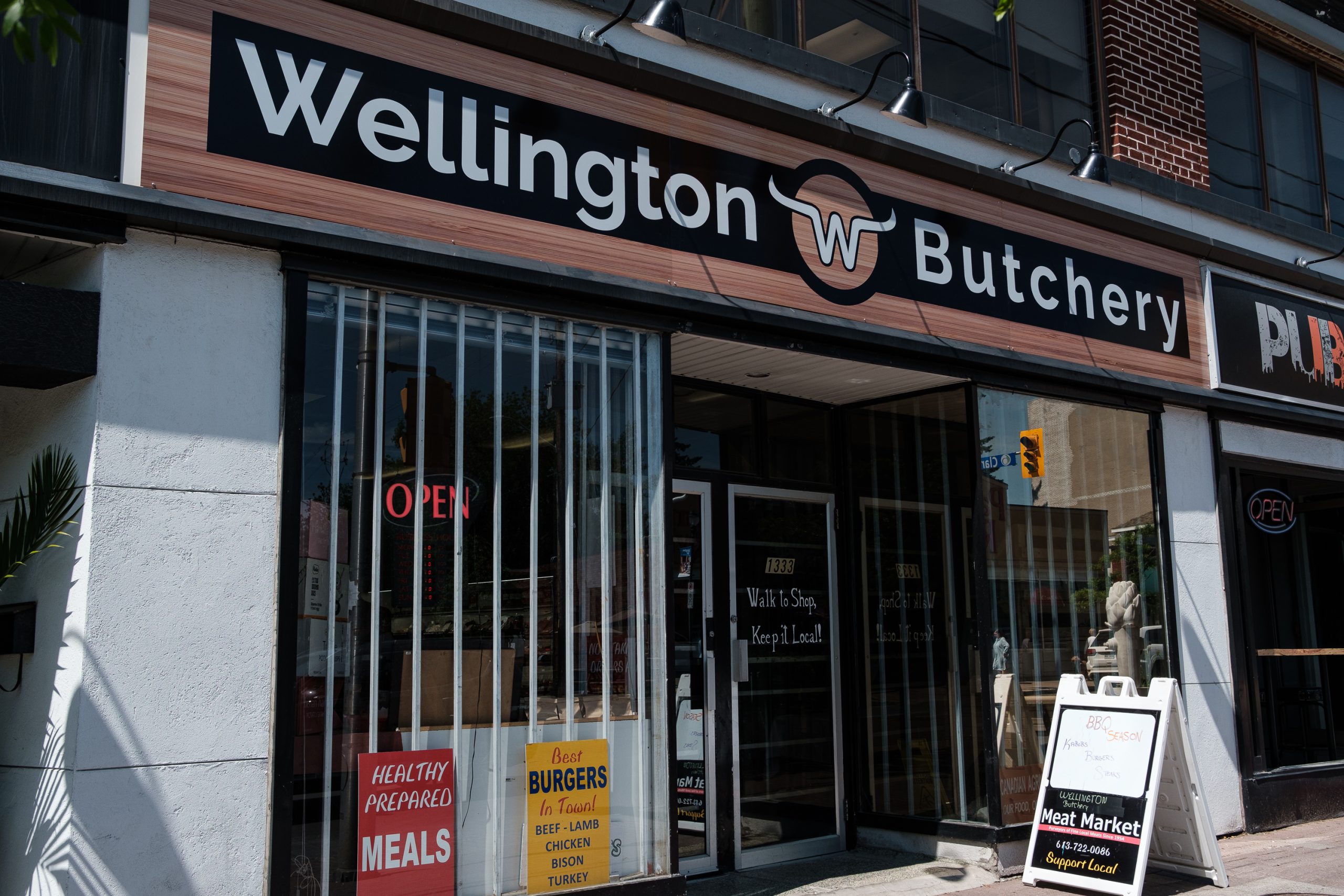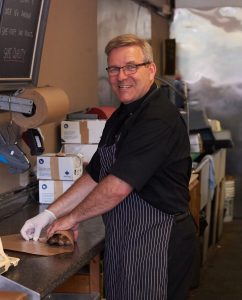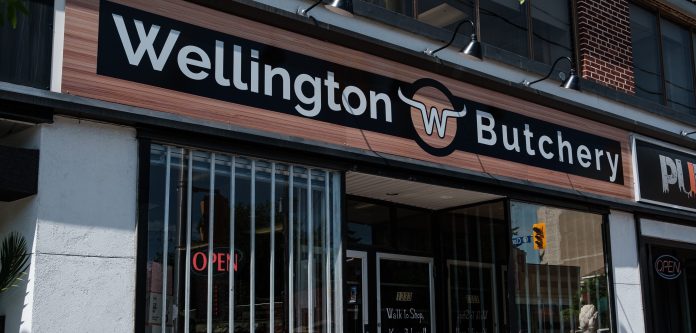
By David Sali –
No matter how you slice it, Joel Orlik seemed destined to have a career in the butchery business.
When he left his job in the newspaper distribution industry a couple of years ago, Orlik, 55, decided to help out his old boss, Joel Diener, at Saslove’s Meat Market on Wellington Street. He’d worked at the store for nearly a decade in the late ’90s and early 2000s before opening his own butcher shop in Barrhaven, a venture that lasted three years.
Orlik then spent more than a decade in the newspaper business. Mulling retirement, he instead ended up back at Saslove’s full-time. When Diener decided to call it quits earlier this year, Orlik again found himself the proud owner of his own store–even if it did take “multiple offers” to get the deal done.
“He wasn’t ready (to leave),” the 55-year-old businessman says of Diener, who’d owned the Saslove’s location on Wellington with his brother John for more than two decades. “This time I told him, ‘Look, I’m gonna retire. If I’m not doing it for myself, I’m not interested in doing it.'”
He chuckles. A fifth-generation butcher, Orlik knows the food business is practically embedded in his DNA. A cousin he recently met in Vienna traced the family tradition back to his great-great grandfather, who was a master butcher in Bohemia in the mid-19th century. From the 1860s until World War II, other members of the Orlik clan operated butcher shops in Vienna, and his uncle later ran a meat market in downtown London.
Now, it’s Orlik’s turn to carry the family cleaver. He officially assumed ownership of the 1,300-square-foot shop at 1333 Wellington St. on June 1, renaming it the Wellington Butchery.
Orlik and the meat business appear to go together like beer and bratwurst.
Eyeing the rows of New York striploins and steaks cut from Ontario-raised wagyu beef–a Japanese breed renowned for its marbling and taste–he passionately extols the virtues of “dry-aging” large cuts of meat in a cooler for several weeks at precisely one degree Celsius.
Pointing to a cut of wagyu, he says it will be “like eating meat-flavoured butter.”
“Beef is not tender till day 28,” he says matter-of-factly. “Personally, I like 42-day aged.”

All the shop’s meat comes from Canadian farms, most of them in Ontario and Quebec. Orlik and his staff of eight do all the butchering in-house in addition to producing an abundance of other barbecue staples, including pork sausages infused with Beyond the Pale’s Darkness stout.
“It makes a really good sausage,” Orlik says with pride. “Very popular.”
NO ‘RUN-OF-THE-MILL’ PRODUCTS
The store also offers a range of prepared items such as cabbage rolls, turkey meatloaf, beef jerky and meat sauce (which Orlik makes himself). He’s a frequent visitor to neighbouring Herb and Spice, dashing across Wellington Street up to three times a day to replenish his stock of fresh ingredients for his creations.
The key to success in the meat business, he says, is adapting to ever-changing consumer tastes.
Today’s customers “don’t want just run-of-the-mill,” Orlik explains. “They want Triple-A, angus, wagyu. They want top quality. If I’m gonna sell what the grocery store sells, I may as well just close the door. I can’t do what they do, and they’re really not set up to do what we do. This is a great neighbourhood. They support their stores, but you have to give them a good product.”
He’s also looking to expand the store’s vegetarian offerings, adding more prepared meals aimed at the growing number of consumers who don’t eat meat or consume it less frequently. His goal is to make one-third of the items at the store’s prepared food counter meat-free.
“I mean, we don’t eat meat every night, and I’ve got access to all the meat I want,” he says. “You’ve got to break it up. If you’re going to eat less meat, you should eat good-quality (food).”
Orlik also plans to give the shop itself a makeover. He wants to expand the basement cooler and move the retail space to the back corner where the butchers now cut and prepare the steaks and other meats. The butchers’ counter will be brought front and centre so customers can see the butchers plying their trade, “like they do in Montreal.”
In addition, he’s floated the idea of offering curbside delivery to customers who call in orders ahead of time, a service that’s gaining traction in other cities.
And he’s already looking even further down the road, to a day when he finally leaves the business he loves. He promised his wife Barb he’d give his latest venture seven years, and then hand it off to the next generation.
To that end, he’s grooming the two young butchers on his staff, Carlos Molina and Anthony Tessier, in the hope that at least one of them will take over when he finally hangs up his apron.
“One of them’s gonna need a future, and then there will be continuity as well,” he says.
But that’s a conversation for another day. Orlik is too invested in his trade–emotionally and financially–to walk away yet.
He mentions that he and Barb just returned from a three-week vacation to Prague, Budapest and Vienna, where they spent much of their time sampling the wares at food markets and, yes, visiting butcher shops.
“Other people go to see paintings,” Orlik says with a wry chuckle. “We go to see food.”
JOEL ORLIK’S GRILLING TIPS
If you’re not a seasoned master of the grill, Orlik suggests sticking with rib steaks or striploin cuts because they usually stay tender even when they’re slightly overcooked. “They’re both excellent,” he says. “For somebody who’s not the best barbecuer or doesn’t spend a lot of time barbecuing, those steaks are the ones they should buy.”
Never toss pork on a red-hot barbecue. “You can’t sear pork,” Orlik says. “Pork doesn’t like sudden changes in temperature. When you take pork and throw it on a hot grill, you ruined it at that moment.” Instead, he recommends setting the meat on the upper rack while you’re warming up the barbecue, allowing the pork to heat up gradually, before putting it on the grill. Follow that advice, and “you’d have to work really hard to ruin it,” he says with a chuckle.
When cooking sausages, brush them with a little oil and grill them over medium heat for 20-22 minutes. Keep turning them, but avoid piercing them with a fork. “If you’re poking holes, you’re guaranteeing you’re going to have a dry sausage,” Orlik explains. Cranking up the heat too much will leave you with a dry sausage that’s overcooked on the outside and underdone in the middle, he cautions.
